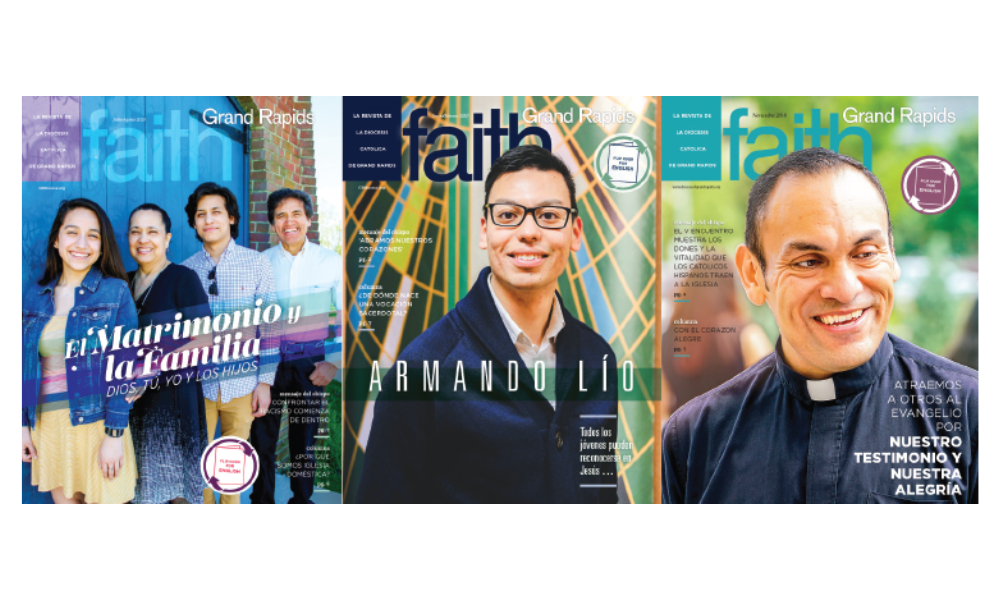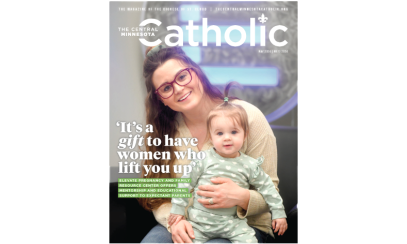
Spanish Content Helps Reach Every Catholic Home
Spanish content reflects bishop's priority to reach every Catholic home
FAITH Grand Rapids publishes Spanish content four times a year. Content Evangelist sat down with managing editor Pat Mish and graphic designer Eric Fuentes to learn more about the publication process and the overall goal of reaching Spanish speakers.
Briefly describe your role with FAITH in the Diocese of Grand Rapids...
Pat: I’m the managing editor of FAITH Grand Rapids magazine. I help plan issues, assign and edit stories, and write news items and occasional features. The magazine is a way to evangelize through story-telling. We hope that the stories we share inspire readers as they seek to deepen their faith and share it with others.
Eric: I’m the graphic designer for FAITH Grand Rapids magazine. I also like to consider myself as somewhat of a visual translator for the stories that Pat sends me. Along with the imagery, I try to present the written word with appealing visuals that help make the meaning shine a little more.
Talk about DGR’s commitment to publishing Spanish content. How did that come about? Why do they believe this is so important?
Pat: With a growing Hispanic Catholic population, the diocese has made Hispanic ministry and evangelization top priorities. Publishing a Spanish-language edition four times a year with content and stories specific to Hispanic Catholics (not translated from the English pages) is a way to reach our Spanish-speaking Catholics and share their faith stories. We know many Hispanic Catholics are not registered parishioners, which means they don’t normally receive the magazine. Therefore, extra issues are printed and distributed to parishes with Spanish Masses and placed onto newspaper holders in local businesses.
Eric: I believe it’s important to reach Spanish-speaking Catholics within any diocese. I praise the Diocese of Grand Rapids on their commitment to include and produce content for the Spanish-speaking community in Grand Rapids. It warms my heart to know that we are considered a viable demographic that needs to be heard.
How does DGR write/design content for a Spanish-speaking Catholic audience?
Pat: I, along with Annalise Laumeyer, editor-in-chief and director of communications, meet with the director of Hispanic ministry, who plans a cover story for each issue and assigns a writer. We also feature a column written by a priest and another that focuses on youth and young adults.
Eric: As a designer, the biggest thing that I consider is to make sure the language is firstly placed on the page in a format that makes sense to the reader (English or Spanish). With Spanish, I have to take certain things into consideration like no hyphenation and making sure headlines break at appropriate points, so it makes sense. Then I work to tell the story visually with colors and elements that I pull from the story and its subjects.
What makes it unique or distinct from content that isn’t created specifically for Spanish speakers?
Pat: We are able to focus on individuals and topics of specific interest to the Hispanic Catholic community, such as migrant ministry, marriage and family with an emphasis on Hispanic culture, Hispanic Catholic faith traditions such as devotion to Our Lady of Guadalupe. A large emphasis over these past two years has been the V Encuentro and accompanying Pastoral Plan process for our local Office of Hispanic Ministry.
Eric: I think the language and how it’s presented makes it visually distinct along with the color pallets I pull from the subjects of any given story.
What assumptions do people make about Spanish-speaking Catholics that might get in the way of evangelization?
Pat: That is a big question! Perhaps the biggest misconception among English readers is an expectation that Hispanic Catholics ought to “learn English” and assimilate into the Anglo culture. To me, this attitude hinders evangelization because it overlooks the richness of diversity within our Catholic Church. We can all benefit from learning more about the many cultures represented within the Hispanic Catholic community, just as historically our church in the U.S. was built largely around the experiences and cultures of various immigrants.
Eric: I agree with Pat. I think the biggest assumption people make about Spanish-speaking Catholics is that we are all Mexican. There are so many other Spanish-speaking Catholics from Puerto Rico, Cuba, Honduras, Venezuela and on and on. Each has their own nuances to being Catholic, their devotions and ways they celebrate their faith.
According to a 2017 study from the Public Religion Research Institute, 52 percent of U.S. Catholics under 30 are Hispanic. Overall, about 40 percent of Catholics in the US are Hispanic. How do these facts impact the way diocesan magazines communicate, both in content and design?
Pat: The Spanish-language edition features a regular column written by or about youth and young adults. The Spanish-language edition also promotes events of interest to those 30 and under, such as youth/young adult retreats and World Youth Day.
Eric: I actually design for the dioceses of Laredo and Reno along with Grand Rapids and notice that they too feature regular columns, events and letters from their respective bishops in Spanish.
As a non-Hispanic editor, have you had to learn new ways of considering content to be relevant and interesting for Hispanic/Latin/Spanish-speaking readers?
Pat: I have been fortunate to be able to collaborate with our director of Hispanic ministry. I have learned more about the issues and priorities that are most important for Spanish-speaking Catholics and have grown in awareness of the diversity within the Hispanic Catholic community. I have also learned to take a “hands-off” approach to copyediting and to be mindful of punctuation differences and the importance of accent placement in names and other words.
Eric, as an Hispanic designer, how has your culture and experience influenced the ways in which you present content?
Eric: I think my culture and experiences have made me aware of the need for diversity within any given magazine. With the support from Faith Catholic and the managing editors I work with, I have been given the freedom to present designs that reflect that. My designs are rarely altered, if anything, I find that some editors request more diversity at times. I’m fortunate to have an outlet that allows me to be creative as well as represent cultural diversity.
Is there anything else you think readers/Catholic communicators should know about how Spanish content works in the Diocese of Grand Rapids?
Pat: We take great pride in offering engaging content to our thriving Hispanic Catholic community. And we have seen growing interest from our Anglo readers about the stories published in the Spanish-language issue, so we translate our cover stories for these four issues into English and place them on our website for people to read. Recently the diocese approved a Pastoral Plan for Hispanic Ministry that identified evangelization as a top priority. We hope that the Spanish-language edition can help advance that goal in the diocese.
Eric: I think the Diocese of Grand Rapids is an exemplary diocese on how they serve content to their Spanish-speaking community. I believe it helps unify the diocese and its many cultures within the Catholic community by showing how faith is universal.
See English and Spanish issues of FAITH Grand Rapids magazine here!



